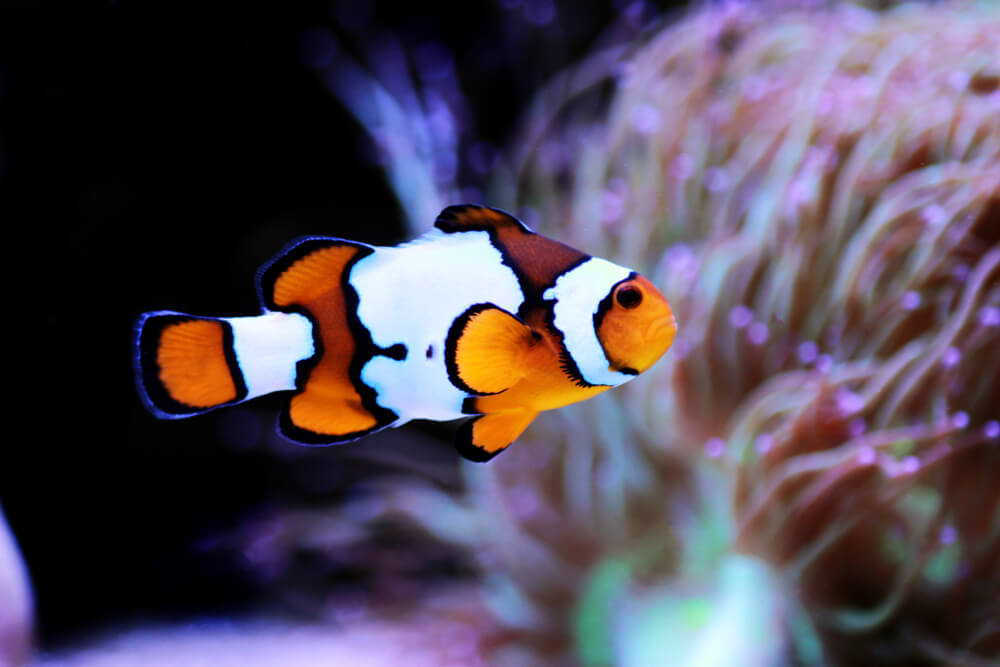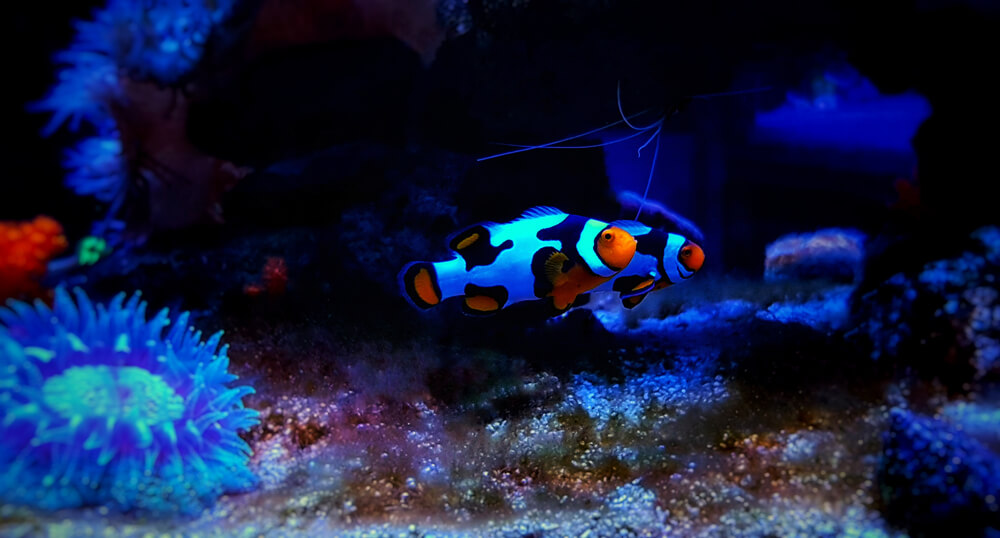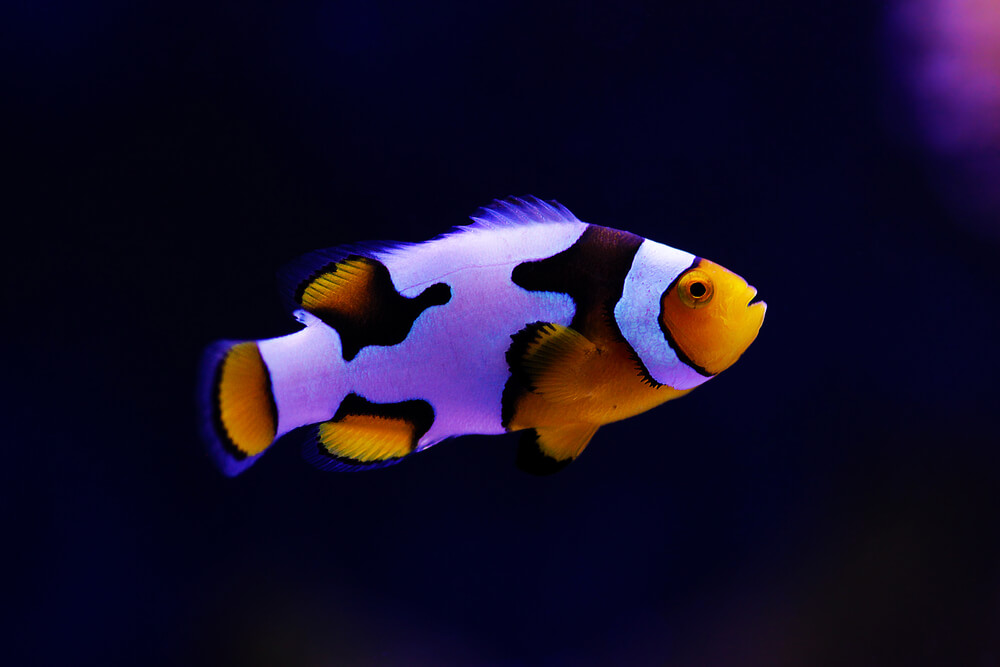Snowflake Clownfish 101: Care, Lifespan, Breeding, Size & More
Posted by Miles Harrison on 09/01/2022
Snowflake Clownfish are a unique saltwater species that can make a great addition to a saltwater aquarium or reef tank. Their unique white coloration makes them an exciting choice when looking to add a Clownfish to your aquarium.
These fish are easy to care for, and typically do well with other tankmates!
In this guide, you will learn everything needed to care for a Snowflake Clownfish. We’ll discuss their habitat, lifespan, breeding, and diet!
January's Giveaways on Light Fish
Species Summary
The Snowflake Clownfish (Amphiprion ocellaris) is a designer Clownfish. It is a variant of the Amphiprion ocellaris fish and was first introduced into the hobby in 1999. These fish are uncommon, as most aquarists will opt for other species, such as the Pink Skunk Anemonefish, or Orange Clownfish (Amphiprion percula).
These fish have very unique personalities, and like other Clownfish will form a symbiotic relationship with a sea anemone. Witnessing this bond in a home aquarium is a site to see!
These fish were first documented when they were produced by Tropical Marine Centre in the UK. Their white markings were once frowned upon by Clownfish collectors, but this genetic oddity has now become highly sought after.
These Snowflake Clownfish share similar care requirements as other Clownfish variations, and demand water conditions are of the highest quality. Providing a pristine tank with an appropriate diet will allow these fish to live a healthy and happy life.

Lifespan
The average lifespan of a Snowflake Clownfish in captivity ranges between 3-5 years.
Similar to other types of aquarium livestock, there is typically a correlation between life expectancy and quality of life. Providing optimal water conditions will extend the life expectancy of this species, with reports of some living for up to 7 years.
Snowflake Clownfish require ammonia and nitrate levels to be at zero, and salinity levels should be between 1.020-1.024. Having water conditions that stress these fish will shorten their lifespans, so be sure to prioritize pristine water conditions!
Appearance
There are many different types of Clownfish in the saltwater aquarium hobby. Usually, Clownfish are typically named after the colors or patterns on their body. Names such as the Red Saddleback Tomato, Maroon Clownfish, and Gold Striped Maroon are examples of variations in naming.
Typically Clownfish are similar in size and physical traits but vary in colors and patterns.
Compared to other types of anemonfish, these fish have a distinct appearance. Named after a “Snowflake”, these clownfish have thick vertical white stripes, sometimes covering a large portion of their body.
The white streaks on a Snowflake Clownfish appear much wider than the common Ocellaris Clownfish variant.
While many Ocellaris Clownfish have proportional vertical white stripes, that’s not the case with Snowflake Clownfish. The white stripes on the body of the Snowflake Clownfish can vary in width, and some sections of the white do not follow any sort of uniform pattern. It’s no wonder that aquarists in the 90s considered the patterns to be undesirable!
Snowflake Clownfish rely on the anemone's protection because unfortunately, they are not great swimmers. They often swim in very erratic patterns, making them easy prey for any potential predators.
The eyes of a Snowflake Clownfish tend to have black coloring surrounding the pupil. This is different compared to true percula Clownfish, which have an orange coloration around the eye.
Snowflake Clownfish also have small mouths in the front of their face, this positioning allows them to consume wyrms and other small forms of invertebrate.
Average Size
Typically, fully grown Snowflake Clownfish tend to grow to about 4 inches when fully grown. When purchased, they usually average between 1.75-2.25 inches in length.
These fish will grow quickly and will reach their full size during adulthood, which is typically between 1.5-2 years of age.

Snowflake Clownfish Care
Snowflake Clownfish are an excellent choice for a beginner saltwater aquarist. These fish are peaceful and easy to care for and will do well if given optimal water conditions.
It’s important to note that water conditions must remain stable for the duration of a clown fish's life. Swings in water chemistry can prove detrimental to the fish and will result in stress and potentially disease.
Tank Size
The recommended minimum tank size for Snowflake Clownfish is at least 20 gallons. Although some aquarists have had success keeping these fish in nano tanks of about 8-10 gallons, we recommend at least 20 to provide adequate space for the Snowflake to swim and grow.
Compared to larger species of Clownfish, such as the Gold Stripe Maroon Clownfish, the Snowflake Clownfish is average in size, and grows to be about 4 inches in length. At this length, 20 gallons is optimal, since it provides ample room for anemones and other potential hiding places for the species.
Water Parameters
The most important part of Snowflake Clownfish care is keeping the water parameters in tip-top shape. These fish prefer harder water, acidic pH levels below 7.0 can be detrimental to a clownfish, as low pH is typically synonymous with low oxygen levels.
This is typical for most Clownfish species, any large swing in water chemistry can shock the fish, so maintaining balanced water parameters is very important.
Snowflake Clownfish prefer warmer temperatures, Amphiprion ocellaris live in tropical waters, where temperatures tend to be on the warmer side. If temperatures drop too low, these fish will become lethargic, and their immune system may become weakened, exposing them to potential diseases.
Some guidelines you can follow for your Snowflake Clownfish would be as follows:
- pH levels: 8.1 to 8.4
- Water temperature: 72°F to 78°F (around 74 to 76 degrees is ideal)
- pH levels: 8.1 to 8.4
- Water hardness: 8 to 12 dKH
- Specific Gravity: 1.020-1.025
Before introducing your Snowflake Clownfish, we recommend testing the water to make sure your aquarium is fully cycled, and parameters remain stable. If the water chemistry levels are imbalanced, make any corrections necessary before adding this species.
Setting Up The Aquarium For Snowflake Clownfish
Snowflake Clownfish are normally kept in pairs, and seek shelter in the tentacles of many commonly available anemones. These fish, although peaceful with other species, may grow aggressive towards other types of clownfish. As such, you’ll want to be sure that you do not already have an existing pair of Clownfish swimming in your aquarium.
Due to their naturally occurring relationship with anemones, you should have at least one established anemone in your aquarium, with tentacles long enough to protect the Snowflake Clownfish. Some potential anemones include the Bubble Tip Anemone, Hammer Coral, and Torch Coral.
Snowflake Clownfish typically prefer a crushed coral, or sand substrate Although Clownfish won’t burrow, having a sandy substrate will provide a large surface area in which biologically beneficial bacteria will grow.
The Snowflake Clownfish’s native variant typically lives in the Eastern Indian Ocean and the western Pacific Ocean but also can be seen in parts of Japan and Southeast Asia. They live in coral reefs and lagoons at a depth of around 15 meters, where they are able to coexist with a wide range of different types of sea anemones. Re-creating this environment to the best of your ability is preferred
This species is considered reef-safe, meaning that they will not pick at or try and eat different types of sea anemones. If you’re keeping a variety of different types of expensive coral, you can rest assured knowing that the Snowflake Clownfish will leave these anemones alone.
These fish will also benefit from having plenty of available live rock throughout the aquarium. Live rock carries a large number of beneficial bacteria and acts as a host to many types of small marine organisms. Snowflake Clownfish will occasionally inspect live rock in search of their next meal!
Let’s discuss equipment. One of the most important aspects of maintaining a successful saltwater aquarium is maintaining good water filtration. You’ll want to aim for at least 15-20 GPH times the tank volume in water turnover. So for a 15-gallon tank, you’ll want around 150-300 GPH in turnover. If your aquarium filter cannot reach this volume, keep adding powerheads until you can hit these numbers.
As for a lid, you’ll want to invest in a high-quality cover or lid for your saltwater aquarium. Snowflake Clownfish are notorious jumpers, you’ll want to make sure there’s no way a fish can try to make an escape by sealing the aquarium top with a tight-fitting lid.
Common Potential Diseases
Snowflake Clownfish are capable of getting many of the common diseases that affect aquarium fish.
One of the most common types of disease is Brooklynella. This highly contagious disease is something that you need to be aware of. This deadly parasite attaches itself to a fish’s gills, rendering them unable to breathe. The parasite is capable of killing the fish in a matter of hours.
If you suspect Brooklynella in your aquarium, you can treat this disease with Formalin. Formalin is a formaldehyde gas that uses methanol as a stabilizer. We won’t go into the specifics of Formalin treatment in this post, but we strongly advise following Formalin instructions carefully in order to ensure the safety of your fish. After treatment, you can isolate the fish in a quarantine tank until it’s fully recovered.
Food & Diet
Throughout the day, Snowflake Clownfish will swim actively throughout the tank looking for new food sources. These fish will forage on algae, zooplankton, isopods, and copepods. They will spend their day munching on algae growing on hardscape such as livestock, as well as any potential leftover food lying on the substrate.
However, you cannot rely on existing algae to fulfill the diet needs of this fish. Feeding the Snowflake Clownfish high-quality flake food, and occasionally supplementing with meaty foods such as mysis and brine shrimp, will help boost this fish’s immune system, allowing them to live a happy and healthy life.
If feeding frozen food, we recommend allowing some time for the food to thaw before adding any food to the aquarium. Frozen water can contain traces of phosphates and ammonia, so allowing this extra time will prevent any unwanted chemicals from entering your aquarium.
Temperament & Behavior
These fish tend to be quite calm and will get along well with other fish species that are known to be peaceful. Snowflake Clownfish will not bother invertebrates such as cleaner shrimp or sexy shrimp, making them a great addition to a community if given enough space.
Throughout the day, these fish are active swimmers, but at night, they will rest peacefully in their host anemone.
You’ll want to avoid adding these fish if there are other clownfish present in the aquarium. Female clownfish will show signs of aggression towards other species. In fact, they can even show signs of aggression towards other fish if not given enough space. Providing ample feeding, and providing enough space, is the best solution to maintaining peaceful Snowflake Clownfish.

Tank Mates
Avoid pairing any aggressive fish with Snowflake Clownfish. If not given enough space and proper food as mentioned previously, Snowflake Clownfish may show signs of aggression towards other fish.
Aggressive fish such as the Clown Triggerfish, the Purple Tang, the Maroon Clownfish, and the dangerous Lionfish, should not be paired with Snowflake Clownfish. It’s best to avoid these types of fish so you don’t run into any territorial issues.
Some of the best tank mates available include Damselfish and Basslets. Some of our favorites include:
- Blue Chromis
- Royal Gramma
- Yellow Tang
- Copperband Butterflyfish
- Green Mandarin
- Dart Fish
- Pink Streaked Wrasse
- Spotted Cleaner Shrimp
- Blood Red Fire Shrimp
- Yellow Watchman Goby
We also recommend providing at least one potential host anemone. Some options are:
- Bubble Tip Anemone
- Long Tentacle Anemone
- Saddle Carpet Anemone
- Delicate Sea Anemone
- Beaded Sea Anemone
As you can see, there are plenty of great options that are compatible with the Snowflake Clownfish. As long as the paired species are known to be peaceful, you should be in great shape!
Breeding Snowflake Clownfish
Snowflake Clownfish are one of many animals that change sex in the wild. Born as juveniles that eventually develop into males, only the most dominant fish in a group of Snowflakes will turn female.
Luckily for hobbyists, it is possible to breed these fish in captivity. You’ll need to be fortunate enough to have a bonded male/female pair. Once bonded, these fish will spawn regularly, and can release up to 2000 eggs at once, which will be defended aggressively by the parent fish.
The difficulty in breeding begins once the eggs hatch and turn into fry. Before the eggs hatch, you’ll need to establish a breeding tank. An aquarium that’s at least 10 gallons will suffice. You’ll want to equip this aquarium with an air stone, heater, freshly made saltwater, and existing tank water. You’ll want to provide some coverage from light for the fry to retreat if they feel threatened. The fry are very sensitive to light and potential stress.
You will need to continuously clean the water and feed the fry over the course of a 2-week period. If you can keep the fry alive after a period of two weeks, you’ve made it out of the “danger zone”, and can now enjoy the benefits of being able to announce you’ve successfully raised Snowflake Clownfish fry!
Conclusion
Now that you’re an expert in understanding the ins and outs of Snowflake Clownfish care, you can finally purchase them! You can find Snowflake Clownfish available for purchase on websites such as eBay and Light Fish
Snowflake Clownfish are some of the most eye-catching types of clownfish in the hobby. What was once a fish that was considered undesirable, is now considered highly sought after. Plenty of aquarists rave about the enjoyment they’ve felt in providing for such an interesting and attractive species.
If you enjoyed reading this post, we’d love to hear from you! Head over to our contact page to send us an email, as we’re always looking to improve our care guides. Thanks for reading!
January's Giveaways on Light Fish


